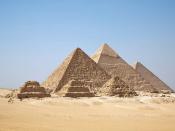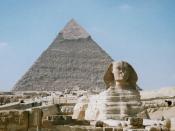Within the hot, dry, desolate desert of Egypt west of the Nile River, lies a silent city. A city once existing during Biblical times before the years of Christ. Its' great temples hold the bodies of famous Egyptian pharaohs, queens and wealthy government officials. These temples, according to the Egyptians, were meant to house these great people during their journey into the eternal afterlife. The pyramids were meant to last ad infinitum; eternity. The Great Pyramid of Cheops in Giza is one of the seven wonders of the world. It still remains an enigma today. Many speculations have been made to how and why these pyramids were erected. Some people thought pyramids were a message from God or they were used in communicating with extra terrestrials. Others have speculated pyramids were built as storage for priceless scientific data and relics, observatories for astronomers or huge food storage in case of famine.
Today we definitely know these ruins were gargantuous tombs for well renowned people during ancient Egyptian civilization due to our increase of knowledge in Egyptian hieroglyphics.
The Egyptians cherished death and looked forward to their own. They believed in an afterlife. Death was a religious event. These tombs were not the big tombs normally seen in a cemetery. To give you an idea of how large these pyramids are, the largest pyramid (the Great Pyramid of Cheops) stood at 485 ft high, that's as tall as a 40 story building. Its square base is thirteen acres; that is approximately the area of seven and a half soccer fields or seven blocks in New York City. The base is almost perfectly level. The stone used in the pyramid is enough to build a low wall around the earth. The most they were off on a side was eight inches.


